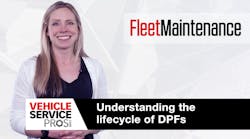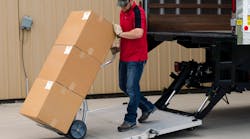An inoperable liftgate can leave drivers unable to load and unload goods, and directly impact on-time deliveries. This is why it knowing and understanding the right specifications for the best performance from your liftgate is critical. The American Trucking Associations’ Technology & Maintenance Council has numerous recommended practices (RPs) providing guidelines on liftgate maintenance and service, under the S.1 Electrical and S.7 Trailer Bodies and Material Handling sections. Gerry Mead, executive director of innovation at Phillips Industries, discusses the challenges fleets face when it comes to properly specifying and maintaining liftgates.
Transcription of interview:
Erica Schueller, Fleet Maintenance: Hello and welcome to VSP News: Uptime Update. I am your host Erica Schueller, Editor-in-Chief of Fleet Maintenance magazine, covering all maintenance, all vehicle classes, all management, all the time.
An inoperable liftgate can leave drivers unable to load and unload goods, and directly impact on-time deliveries. This is why knowing and understanding the right specifications for the best performance from your liftgate is critical.
I talked with Gerry Mead, executive director of innovation at Phillips Industries about the challenges fleets face when it comes to properly specifying and maintaining liftgates.
Gerry Mead, Phillips Industries: Specification is a good topic. Drained liftgate batteries is the number-one issue for liftgates to become inoperable out on the road.
First and foremost, you must start with the right specifications. Secondly, you must have the right PM (preventive maintenance) program.
The right spec comes through in many different methods. There is a great RP (recommended practice) that breaks down several questions for you to ask.
One thing you should ask first is “what are you hauling?” Secondly, "what’s your length of haul?" Right there, that’s going to set you up for your liftgate and your power requirements. Once you get your power requirements, that will dive into all kinds of other RPs that go to S.1 from your wire sizing all the way through to what type of charging.
Schueller, Fleet Maintenance: As Mead mentioned, the American Trucking Associations’ Technology & Maintenance Council has numerous RPs providing guidelines on liftgate maintenance and service, under the S.1 Electrical and S.7 Trailer Bodies and Material Handling sections.
Diving into the details of proper amperage of liftgate operation, Mead talks more about what fleets should consider during the specification process to ensure proper operation of the liftgate – especially how it relates to these RPs.
Mead, Phillips Industries: When you think about determining amperage you must point directly to the RP. And, there are several RPs besides S.7, like S.1. When you think about the different gauges of wiring [such as 2-gauge versus 4-gauge] it’s all determined on what your draw is going to be, because you’re going back to resistance and Ohm’s law.
You must also understand the length of wire. That also will have some voltage drop, that will again determine the size of wire and amperage you want to use.
That all ties back to your tractor. A tractor is an important component of charging that liftgate battery – unless you have a solar option available. So you may want to look at upsizing your alternator.
Again there are several RPs from S.1 to S.7 that tie in liftgate size, wiring size and terminals, to give you a liftgate system that will not fail you on the road.
Schueller, Fleet Maintenance: Ongoing monitoring and maintenance of these systems is important to ensure liftgates stay operating for their intended lifecycle. Mead provides more detail on what fleets should consider when maintaining liftgates.
Mead, Phillips Industries: It all starts with your PM program. Really, there’s a great TMC liftgate inspection procedure under S.7 that really gets to the main points. But also, go back to the basics.
Really when you’re talking about charging a system where your batteries are you major failure. Clean those battery terminals, even all the way back through your auxiliary cable, or if you’re using some kind of auxiliary system – like the Smart Stay Charge from Phillips – look at your 7-way.
Then, make sure you go back and review – especially if you’re taking over [or starting with] a fleet for the first time – look at the specs. Make sure you’re handling equipment that is specified correctly.
One great thing that has happened in the liftgate community today is, there is also a telematics option where you can really look, see, and understand problems with your liftgate before they occur. We have a great partnership with a lot of liftgate manufacturers to where we can give you telematics, diagnostics, power, and other items about that liftgate, back to your computer terminal so that you as a fleet maintenance professional can look and see what’s happening on your equipment while it’s out on the road.
Schueller, Fleet Maintenance: Efficient liftgate operation and optimal system life begins with proper installation. Mead talk more about this.
Mead, Phillips Industries: Everything ties back to specifications when you talk about proper installation. There’s a lot of things you need to know when ordering your liftgate.
One: do you require an ICC bumper? Do you want a side liftgate, a rear liftgate, a rail liftgate, tuck under liftgate? All those come into play.
When you talk about proper operation, you need proper operational training. The operator needs to understand how to properly operate that liftgate, and what he or she needs to do to maintain the charge on the batteries.
Length of haul plays a big role in the operation part. Without the proper training for technicians, or drivers, from that manufacturer after you decide which manufacturer fits your operation the best, you’re going to continue to have failures.
So first, go back to the TMC references, talk to your sales representative for that liftgate manufacturer, and really understand what it’s going to take to get you a liftgate that won't fail on the road so you can deliver your freight on time, every time.
Schueller, Fleet Maintenance: If you’d like more information on how to spec, maintain, and troubleshoot liftgate performance, go to the link below to access a recent feature story from Fleet Maintenance on this topic.
That’s it for this week’s episode! Thank you for tuning in to VSP News: Uptime Update, I’m your host Erica Schueller.
Until our next broadcast, keep up with this, and other industry topics, by visiting us online at VehicleServicePros.com.
Find more information on how to specify, maintain, and troubleshoot liftgate performance.


